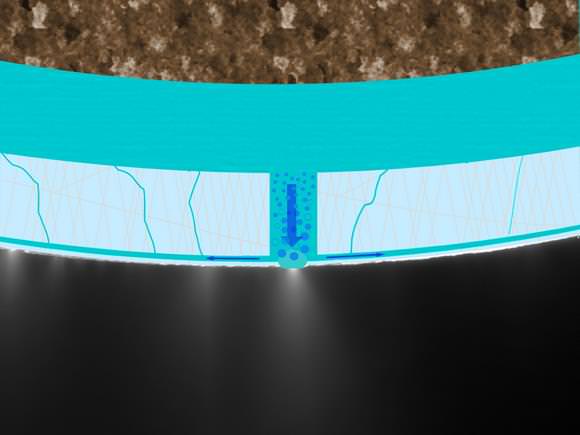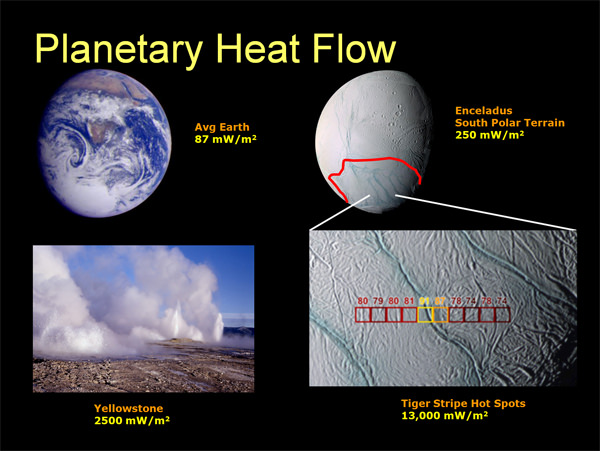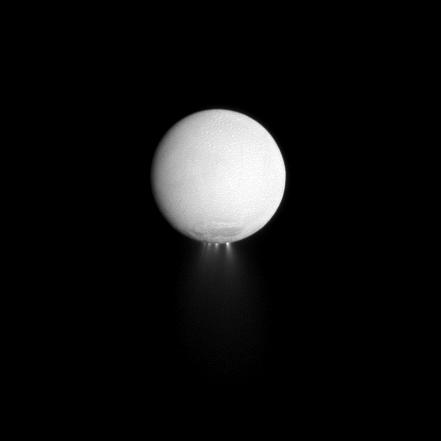Universe Today | Enceladus | 05 Oct 2010
Bubbly Ocean on Enceladus Explains Plume MysteryBottled water companies take note: an exotic form of warm, bubbly mineral water could be what feeds the mysterious jets spraying from the south polar region of Saturn‘s moon Enceladus. A new model of the sub-surface ocean explains how the small moon could be so cryo-volcanically active. The Cassini spacecraft has detected sodium and potassium salts, as well as carbonates in the water vapor plumes spewing from the moon, which indicates a liquid, bubbly subsurface ocean. “There is a plume chamber, where some of the bubbles can pop the cap of the thin ice crust, and through that process is how the plumes get sprayed out,” said Dennis Matson, a NASA planetary scientist from JPL, speaking at a press briefing at the American Astronomical Society’s Division for Planetary Sciences meeting in Pasadena, California.
...
“What we think is going on is that Enceladus has a subsurface ocean where water, heat and chemicals are stored before they erupt,” he said. There is an ice crust, many tens of kilometers thick. The ocean is gas rich, — and previous researchers dubbed such an ocean as a ‘Perrier’ ocean -– which basically “pops the cap” of the ice crust.
“What is happening is that water comes up and pressure is released,” said Matson. “Gases and water come out and the bubbles come near the surface and supply materials to the plumes. Water also transfers laterally, to a great extent, from the point of the plumes. This transfers heat to the surface, by analogy, like the radiator on your car. You have water coming out, which transfers heat to the thin ice layer, and then the heat is radiated to space. Cooled water goes down through cracks in the ice where it gets ready for another trip to the surface.“
Cassini also found an impressive amount of heat flow over a small area coming from Enceladus’ interior. About four years ago, Cassini’s composite infrared spectrometer instrument detected a heat flow in the south polar region of at least 6 gigawatts, the equivalent of at least a dozen electric power plants. This is at least three times as much heat as an average region of Earth of similar area would produce, despite Enceladus’ small size.
“To put the heat flow in perspective,” said Matson, “the heat flow for the Earth has 87 of these units, but on the south pole of Enceladus, 250 units. At Yellowstone, there are 2500 units, but at one of the tiger stripe hots spots on Enceladus, we find heat flow as big as 13,000 units.”
The heat is, of course, relative to the surrounding environment. The subsurface bubbly water is probably just below freezing, which is 273 degrees Kelvin or 32 degrees Farenheit, whereas the surface is a frigid 80 degrees Kelvin or -316 degrees Farenheit. However, Matson said they have also seen surface temperatures as high as 180 K, when only 70 K was expected at the south pole.
Finding the sodium in the icy grains in the plume is huge piece of evidence pointing to a subsurface ocean. Previously, Earth-based observations did not detect salts in the plume, and so scientists didn’t think a liquid ocean was possible. But infrared observations with an instrument on Cassini found the particles in the plumes include water ice, and substantial amounts of sodium and potassium salts and carbonates, as well as organics.
...
Also new is that the heat from Enceladus appears to be originating in the ocean, and also the realization there is a circulation system inside the moon, where there is process of pumping the water to the surface.
AAS DPS Presentation Abstract
Wired Science | Space | 05 Oct 2010
Eau! 'Perrier Ocean' Could Give the Kick to Saturn Moon's Geysers
Space.com | Science | 05 Oct 2010
Enceladus: Highlighting Plumes


